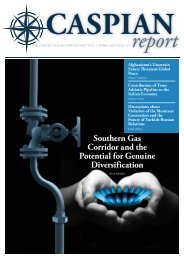Create successful ePaper yourself
Turn your PDF publications into a flip-book with our unique Google optimized e-Paper software.
FATIH MACIT, HOLLY REHM<br />
12<br />
SINCE THE START OF THE SHALE REVOLUTION, 150,000<br />
HORIZONTAL WELLS HAVE BEEN DUG AT A COST OF<br />
APPROXIMATELY $1 TRILLION.<br />
ing companies such as China’s Sinopec,<br />
France’s Total, and Norway’s<br />
Statoil. 17 Since the start of the shale<br />
revolution, 150,000 horizontal wells<br />
have been dug at a cost of approximately<br />
$1 trillion. 18 Each shale well<br />
costs between $3 and $12 million<br />
to drill. 19 Top overseas companies—<br />
such as Japan’s Mitsubishi Corp and<br />
Mitsui & Co— continue to invest in<br />
shale oil and gas in the U.S., despite<br />
major write-downs of more than<br />
$600 million as a result of low gas<br />
prices and reduced reserve estimates<br />
over the past two years. 20 However,<br />
there continue to be positive incentives<br />
for foreign companies to invest<br />
in shale energy, including operating<br />
in a stable country with low political<br />
and legal risks, and gaining knowledge<br />
of fracking and horizontal drilling<br />
which could be useful in development<br />
of domestic shale reserves. 21<br />
A report by IHS Global Insight estimates<br />
that more than $5.1 trillion in<br />
capital expenditures will be spent in<br />
the U.S. unconventional oil and gas<br />
industry between 2012 and 2035,<br />
with around $3.0 trillion of that spent<br />
specifically on unconventional natural<br />
gas activity. The report further<br />
notes that employment in the unconventional<br />
oil and gas sector supported<br />
1.7 million jobs in 2012, projected<br />
to double, reaching 3.5 million jobs in<br />
2035. Finally, in 2012, the unconventional<br />
gas and oil industry accounted<br />
for nearly $62 billion in federal, state,<br />
and local taxes. IHS projects that<br />
shale oil and gas activities will cumulatively<br />
generate more than $2.5 trillion<br />
in tax revenue between 2012 and<br />
2035. 22<br />
Moreover, additional supplies of domestic<br />
natural gas have put downward<br />
pressure on prices in the U.S.,<br />
saving the country billions in energy<br />
expenditures. The U.S. price of gas<br />
dropped close to $2 per million Btu<br />
in 2012, but has since risen—thanks<br />
to an extremely cold winter—and is<br />
now fluctuating around $4-$5 per<br />
million Btu. This is still nearly 3 times<br />
lower than the price in Europe and almost<br />
five times lower than in Asia. 23<br />
Lower gas prices have saved the U.S.<br />
approximately $300 billion annually<br />
in comparison with consumers in Europe<br />
and Asia. 24<br />
Further, cheap gas and a rise in natural<br />
gas liquid production has led to<br />
boom in manufacturing, specifically<br />
in the chemical and petrochemical industry.<br />
An increase in unconventional<br />
oil and gas drilling has also led to a<br />
rise in the production of natural gas<br />
liquids (NGLs), which include ethane,<br />
propane, butanes, and light naphtha.<br />
17.<br />
EIA, “Foreign investors play large role in U.S. shale industry,” http://www.eia.gov/todayinenergy/<br />
detail.cfmid=10711. Accessed June 17, <strong>2014</strong>.<br />
18.<br />
Hefner, “The United States Gas.”<br />
19.<br />
IHS Global Insight (2012) “America’s New Energy Future: The Unconventional Oil and Gas<br />
Revolution and the US Economy,” 19.<br />
20.<br />
James Topham, “Japan trading houses keep faith in U.S. shale despite writedowns,” http://www.<br />
reuters.com/article/<strong>2014</strong>/05/<strong>08</strong>/japan-trading-house-shale-idUSL3N0NO0J8<strong>2014</strong>05<strong>08</strong>.<br />
Accessed June 17, <strong>2014</strong>.<br />
21.<br />
EIA, “Foreign investors play large role.”<br />
22.<br />
IHS Global Insight, “America’s New Energy Future,” 2.<br />
23.<br />
BP, “BP Statistical Review of World Energy June <strong>2014</strong>,” http://www.bp.com/content/dam/bp/<br />
pdf/Energy-economics/statistical-review-<strong>2014</strong>/BP-statistical-review-of-world-energy-<strong>2014</strong>-<br />
full-report.pdf. Accessed June 20, <strong>2014</strong>.<br />
24.<br />
Hefner, “The United States Gas.”










